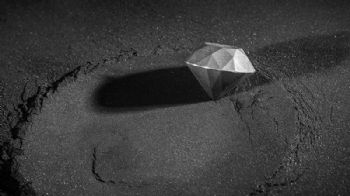
Sandvik Additive Manufacturing has created the first ever 3-D printed diamond composite; and while this diamond does not sparkle, it can be used for a wide variety of industrial applications.
The new process developed by Sandvik means that this super-hard material can now be 3-D printed in highly complex shapes and “revolutionise the way industry uses the hardest natural material on the planet”.
Diamond, the hardest naturally occurring material, is a key component in a large range of wear-resistant tools in industry, from mining and drilling to machining.
Since 1953 it has been possible to produce synthetic diamond, but since it’s so hard and difficult to machine, it is almost impossible to form complex shapes.
However, by using additive manufacturing and a tailor-made proprietary post-processing method, Sandvik has managed to 3-D print diamond composites into almost any shape.
The difference between Sandvik’s diamond and natural or synthetic diamond is that it is a composite material.
Most of the material is diamond, but to make it printable and dense it needs to be cemented in a very hard matrix material, while keeping the most important physical properties of pure diamond.
Anders Ohlsson, delivery manager at Sandvik Additive Manufacturing, said: “Historically, 3-D printing in diamond was something that none of us imagined was achievable, and even now we are just starting to grasp the possibilities and applications that this breakthrough could have.
"We began to wonder what else would be possible with having the ability to 3-D print complex shapes in a material that is three-times stiffer than steel, has a heat conductivity greater than copper, a thermal expansion that is close to that of Invar — and a density near that of aluminium.
"These benefits make us believe that, in just a few years from now, diamond composite will be seen in new advanced industrial applications ranging from wear parts to space programmes.”
Mikael Schuisky, head of R&D and operations at Sandvik Additive Manufacturing, said (
www.additive.sandvik/en): “We are printing in a slurry consisting of diamond powder and polymer using a method called stereolithography, where complex parts are produced, layer by layer, using ultraviolet light.
"The step after the 3-D printing is the one for which Sandvik developed a post-processing method that makes it possible to achieve the exact properties of the super-hard diamond composite.
"This step was extremely complicated, but after extensive R&D efforts and several trials we managed to take control over the process and make the first 3-D printed diamond composite.”